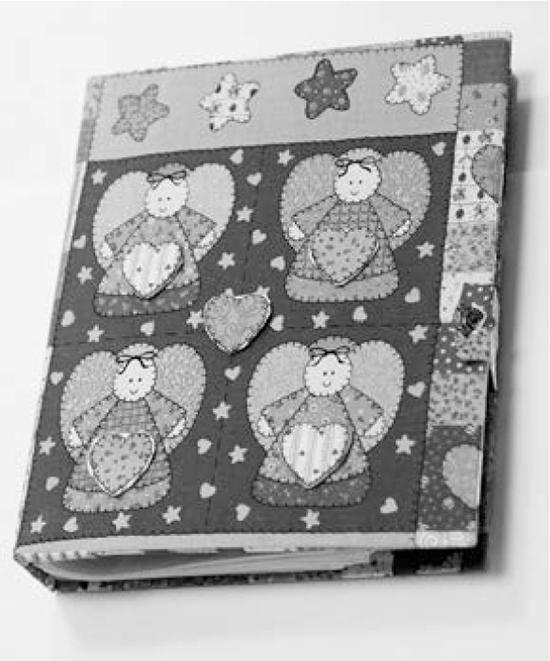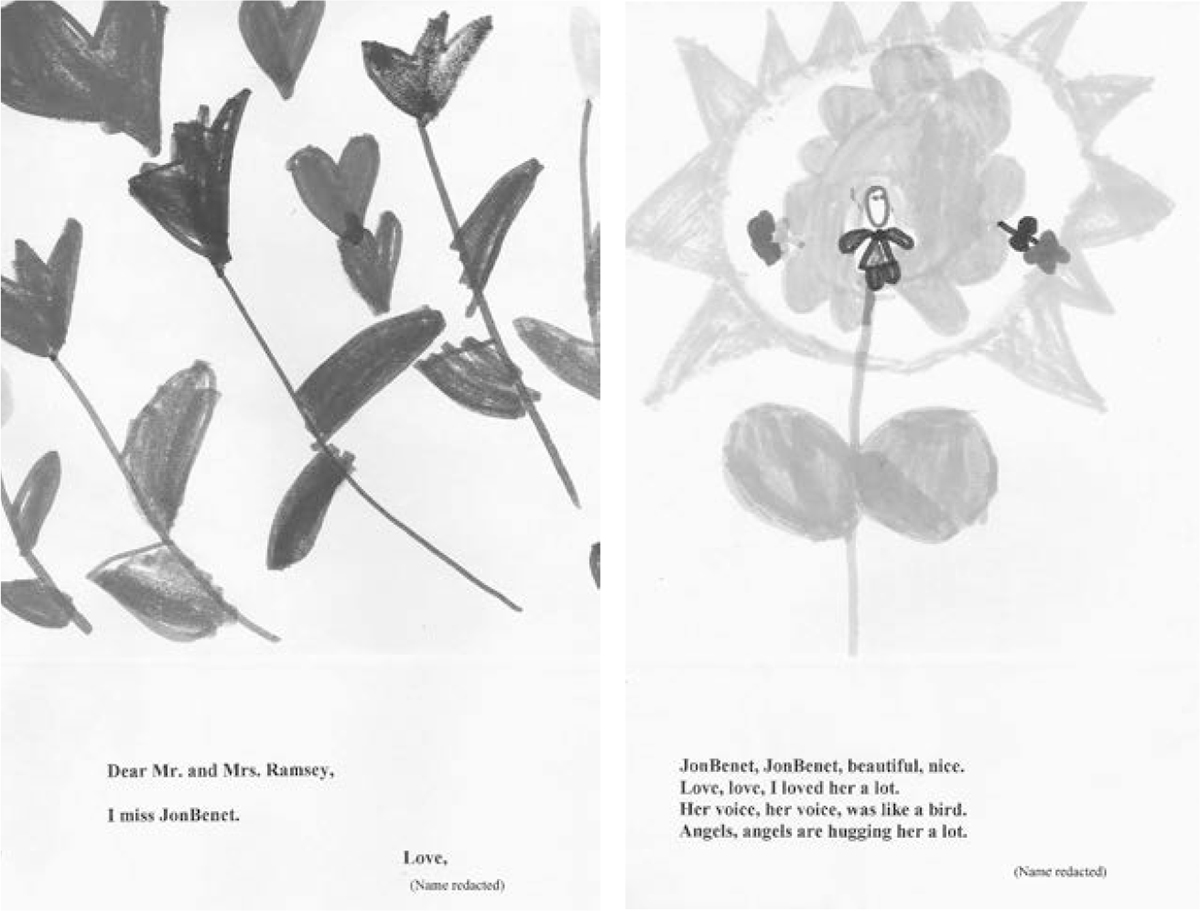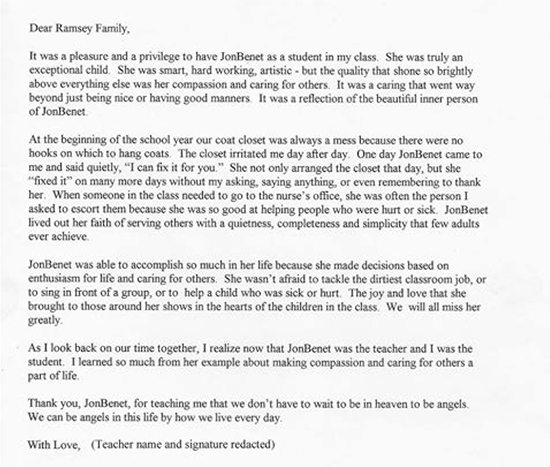AUTHOR’S NOTE
DETECTIVE LOU SMIT’S BATTLE with colon cancer was brief; eight weeks between diagnosis and his death in August of 2010. He remained committed to the Ramsey’s innocence believing that an intruder, “a sexual predator,” killed JonBenét.
During a visit with him shortly before he died, he clasped my hand from his hospice bed and looked at me with exhausted eyes. “You know, I’ll know before you will who the killer is.”
Lou was a man of strong religious convictions and his conclusion was that of the two alternatives, he would be going to heaven to spend his after-life there.
I smiled and replied, “Is there some way you’ll be able to send a signal or sign of who the killer is?”
In his sincerest, but weakened voice, “I would, but I don’t know what the rules are there yet.”
There is a binder with Angels and Hearts on the cover. Inside are letters and pictures to JonBenét’s parents from her school classmates. A friend had kept it for the family all these years and John had just found it and was looking at it for the first time.
The children who painted the pictures and wrote the notes to the family and JonBenét are now in their twenties, like JonBenét would be. They didn’t understand what death or murder meant when they wrote their notes and drew their pictures. But their innocence adds depth to the portrait of the little girl they knew. Teacher and student names have been changed for privacy.
The bookbinder is covered with smiling gingham angels with wings and hearts. The book clasp is a heart. Inside, the colors red, yellow, green, turquoise, orange and blue burst out of the pages. They are happy colors, just like those JonBenét used in her own drawings. There are rainbows and flowers and pictures of JonBenét.

Binder with angels and hearts prepared for the Ramsey family by JonBenét’s kindergarten class in 1997. It included drawings from her classmates. © John Ramsey
“This is JonBenét holding a flower,” writes a classmate, in a childish scrawl with a drawing of a red flower held by a girl in a turquoise shirt with blonde hair and a smile on her face.
Another drawing has a pink heart with JonBenét’s name in purple and the words “JonBenét was my best friend. I rele mis her.”
There are suns and houses and trees, and in every one of the pictures of JonBenét, she wears a smile. That’s what her friends and teachers conveyed. She always smiled.
“JonBenét, JonBenét. I liked her a lot. She’s an angel now up in the sky,” from a friend who painted flowers and a happy JonBenét.
One of her teachers tells how JonBenét helped clean up a closet and shared a cupcake when they were short one at a birthday party. The teacher recalled sending JonBenét to the school nurse with a sick student. She was used to being around sickness because of her mother’s cancer. To her, it was simply part of her life. She was kind, the teacher wrote, and always asked her classmate how she felt. JonBenét also assured the sick child that the nurse or their mom or dad would make them feel better.

Drawings from JonBenét’s classmates for the Ramsey family after her murder. © John Ramsey

Kindergarten teacher’s letter to Ramsey family about JonBenét.
Another teacher said once when she saw JonBenét walking down the hall “she gave me a wide smile, a bear hug and she stuck like glue and we walked down the hall together, her feet on my feet and arms around my middle, muddling along.”
“Thank you, JonBenét, for teaching me that we don’t have to wait to be in heaven to be angels,” wrote another teacher.
Recently, John sat alone in a chair and opened the Book of Angels for the first time. He was reluctant because he was unsure how he would react. For many years now, he has tried to keep his emotions on an even keel. It’s one of the ways he has survived the trauma. He finds it very difficult to be reminded in detail of the past. Still he feels he owes it to himself, his daughter, and JonBenét’s classmates from so very long ago, to look at their work. He leafed through the binder slowly, running his hands across some of the pictures and silently mouthing the scrawled inscriptions.
“I had forgotten what joy there is with a six-year-old,” he said as he looked at page after page of the sweetness that was in his daughter’s life.
And then, he put his hand on his forehead and partly covered his eyes as they filled with tears.
In early 1997, I reported that two expert sources, one from the prosecution and one from the defense, said it was “highly unlikely” that John or Burke Ramsey had written the bizarre ransom note and “unlikely” that Patsy Ramsey had written it. The report created a big push-back from the then Director of the Colorado Bureau of Investigation. An employee in his agency was examining the note. The Director charged the report wasn’t accurate and appeared on television and radio saying that no one on the prosecution side believed it was “unlikely” Patsy Ramsey had written the ransom note.
What followed was a reporter’s classic dilemma—what to reveal and what not to reveal when “legitimate sources” are involved. I needed to honor my commitment of protection to the prosecution source, thus I was unable to vigorously counter the allegations. To do so would have exposed the source by inference. It is likely that source would have been fired had I continued to defend my reporting with sources from both the prosecution and defense sides on the handwriting in the ransom note.
The accuracy of that source was proven in late October of 1997, when the Boulder Police Department decided to get more than just one handwriting analyst’s report. The BPD carefully expanded their pool of experts. An analyst for the Secret Service, considered among the world’s leading document authorities, wrote in his report to the BPD that there was no evidence Patsy Ramsey wrote the note. She never was arrested with regard to her handwriting and the ransom note, because there wasn’t ample proof and the Secret Service information has not become public until now. This is a behind-the-scenes look about the complexities in understanding the commitment of balanced reporting and the involvement with protection of a source that was part of this book.
In the early days after JonBenét’s death, what no one outside the Ramsey inner circle realized were the hundreds of letters the family received internationally, expressing sympathy to them. It’s a new perspective of the support they got from those who didn’t know them. Some of those letters and cards were simply addressed to “The Ramsey Family” and were delivered wherever they were staying. An example:
We believe you. We are praying for you and are so very sorry.
(Name Withheld) Canada
There are two current law enforcement officers whom I consider very thoughtful and observant. They are former Boulder police officers who talked just briefly with me about the morale of some of the men and women in their department after the murder when they were still working there. “It was picking up their chins off the floor. It was trying to find the killer of a child. There isn’t anything worse when we are supposed to serve and protect. It was reinforcing to them that there were very good officers in the department. It was telling them not to watch late-night television entertainment shows where there were skits making fun of Boulder police and their incompetence. It was getting them to believe in themselves again.”
After the murder, a highly regarded homicide expert and then Denver Police Sergeant Jon Priest was asked to come to Boulder to teach basic Crime Scene Investigation for three months to every member of the department.
Those in law enforcement who made the decision to talk about the case for this book, but didn’t want to be identified, have my great gratitude and respect. It was unnerving for some of them and many didn’t want to go back to remembering that awful time in detail. But they did it mostly because they thought it was the right decision for them. In listening to them and rechecking their information, they were straightforward, forthcoming and insightful. They are the best in law enforcement officers— honest and honorable.
To the readers of this book, thank you for your time and comments. This is the best information that I could research and gather, but it’s certainly not all of it. I was prompted to write this book because of curiosity about what I didn’t know, even after reporting on the story for these many years. I began writing the book in mid-2009.
Those of you who are devoted to this business and have a passion for journalism deserve a thank you for staying with and continuing to do the best in tough times. Investigating and reporting what happens with accuracy is so important to our society. My best conversations were with a lot of you when hashing out what to include, what not to include and why, and I’m reminded how many truly committed people there are who do it right.